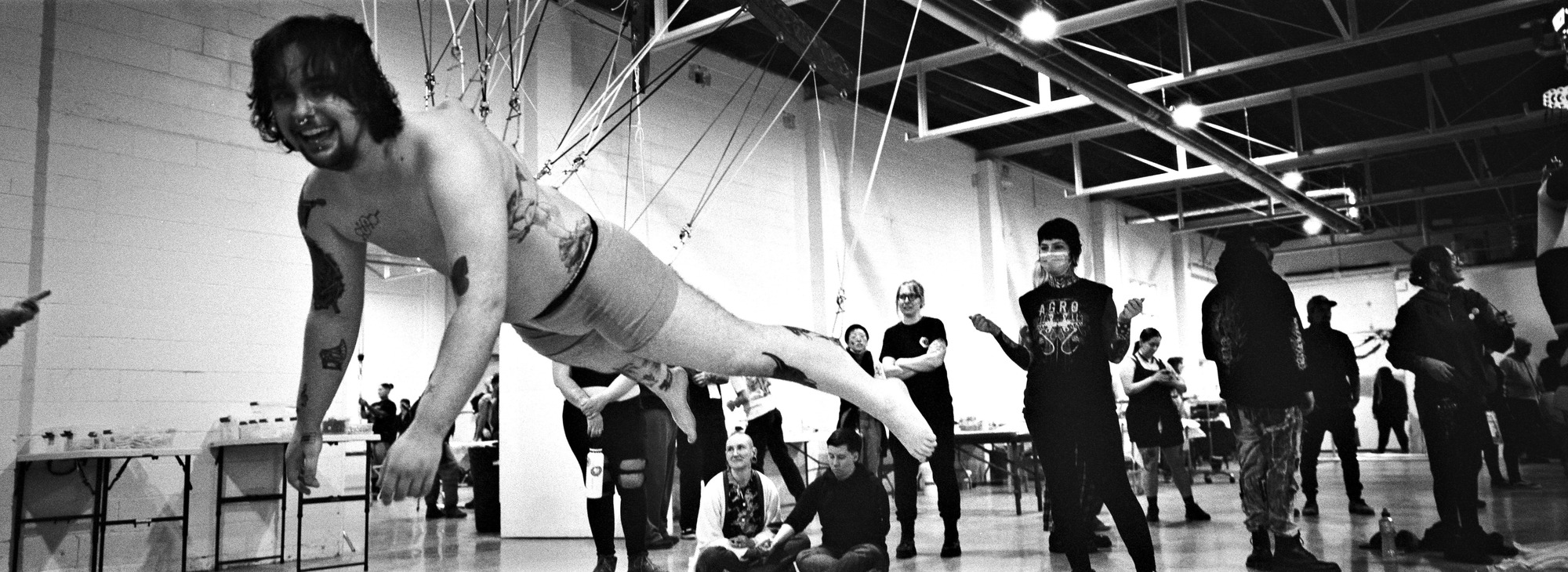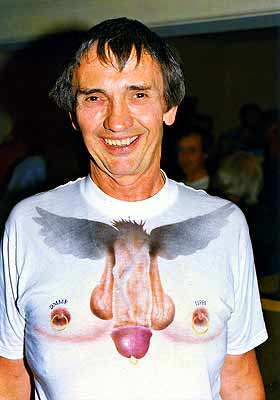
Who Was Doug Malloy? part one Doug Malloy was what an acquaintance of mine called the “nom de kinque” of a wealthy Hollywood businessman named Richard Simonton. I was given to understand that Malloy was his mother’s maiden name. Being an Irish name, I can’t help thinking one of his forebears must have kissed the Blarney stone, for Doug had a remarkable flair for telling a story, and if it wasn’t exactly true, it didn’t particularly matter to him as long as the tale was a good one. Consequently I can’t guarantee the accuracy of everything that Doug told me about himself or about the history of piercing for that matter. But he told wonderful stories, and the fact that many of them persist despite a lack of any supporting evidence says much for his ability to capture our imaginations. 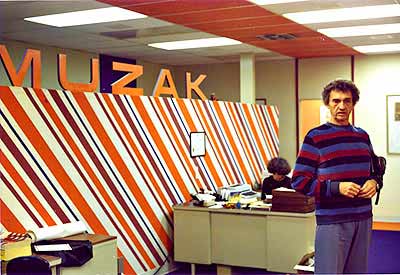 Doug in the Muzak offices in Hollywood. I know little about his youth. From an early interview it appears he was born in Chicago and his family moved to the Seattle area when he was about three. By the time the Depression hit in 1929, he would have been in his early teens. I gathered the family wasn’t exactly affluent. Eventually he ended up in Southern California and his fortunes began to change. In the early 40s he struck a lucrative deal with Muzak, the ubiquitous background music company, which gave him control over the southwestern quarter of the country. It made him a very rich man. Doug was quite interested in things metaphysical. He had been a personal friend of Ernest Holmes (1887–1960) author of The Science of Mind and the founder of the Religious Science movement. Thanks in no small part to Holmes’ influence, he was very much a believer in what became known as the “power of positive thinking.” He also believed in reincarnation. According to Doug it explained not only things like prodigies, but also why some people became passionate about things like body piercing. This, he claimed, was his own case. He remembered a past life during which he had been a highly placed courtier in the entourage of Egyptian pharaoh Akhenaton. Supposedly navel piercing was common amongst the aristocracy but forbidden to the lower classes. Doug claimed that the piercing could be seen in statuary, but try as I might I was unable to see it in the photos which he showed me. Within the last 50 years scientists have been able to construct an extremely clear and accurate picture of Egyptian life dating back several thousand years. To date I am unaware of any evidence having been discovered that would substantiate Doug’s claim. Meanwhile back in ancient Egypt, Doug’s ancient self had a jealous rival at court who arranged to have him murdered. This left a karmic debt that the rival was attempting to repay in Doug’s present incarnation. From time to time the “Little Man” as he was called would appear and offer Doug advice and occasionally make predictions. I know of at least one that wasn’t accurate. Doug was told he’d live to the year 2000. Maybe by some antiquated calendar. At least by our calendar he was off by nearly 25 years.  Doug walking in his back yard at the edge of Toluca Lake. Doug had an incredible home in the San Fernando Valley. Allegedly he had been told psychically to start construction on it even before he’d amassed the fortune necessary to complete it. It was in an area called Toluca Lake, named after the small body of water on the edge of which the house was being built. To the best of my knowledge there is no public access to the lake itself because it is completely surrounded by homes. Warner Brothers studio is a short distance to the East. Doug’s neighbors included Bob Hope, Olivia de Haviland, and Walt Disney’s brother Roy.  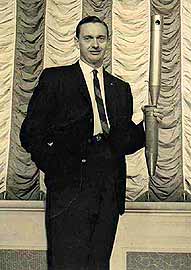 Left: Doug’s living room with its church-style organ, Right: Doug, circa 1950, with a theater organ pipe in his hand. From the street, the house itself was not particularly impressive. It appeared to be a modest, modern, one-level box. But inside it was a marvel. There was an atrium with a roof that could be retracted. The house had not one, but two pipe organs. One was a church-style organ in the living room. A narrow spiral staircase lead down to a small, 99-seat theater in which there was a fully restored Wurlitzer theater organ dating from the 1920’s. During the silent movie days it had graced a Paramount Studio sound stage. Doug’s interest in theater organs inspired him to found the American Theater Organ Society in 1955. 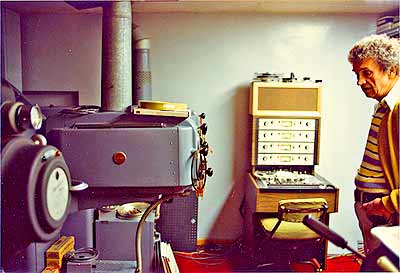 Doug in his theater projection booth. The theater was equipped with state of the art projection and recording facilities. On several occasions a few other Tattoo & Piercing group members and I were invited to join some of Doug’s other friends for private showings in the theater. Doug had been a very close friend of the comedy film star of silent movie fame, Harold Lloyd. When Harold died in 1971, Doug was the executor of his estate. This gave him access to all of Harold’s old films. Another close friend was an old theater organist named Gaylord Carter. Quite naturally things came together for showings of several Harold Lloyd silent films accompanied live by Carter. These were truly once-in-a-lifetime experiences, and I’ll never forget them. Doug’s interests were many and varied. In addition to organs, he had a passion for steamboats. In 1957 he and his family took a trip on the Mississippi riverboat the Delta Queen. On learning that the company was about to go under and this was to be its final season, Doug purchased controlling interest in the company in 1958. With his entrepreneurial skills he quickly turned it into a highly profitable enterprise. I was not fortunate enough to have met Doug at the height of his prowess. A few years previously he had sustained brain damage from an event which nearly killed him. This had effected his ability to express himself. He confided in me that he had once been “an eloquent speaker” and was actually planing to pursue a political career when it all came to an abrupt end. The experience also forced him to take things easier and freed him to indulge his other great passion, body piercing. During one of our many conversations Doug confided in me that had he been born at a later time he would probably have been gay. But he was born at a time when such a lifestyle could easily make anyone an outcast. He had ambitions, and he also believed that he and the members of his family had been together in a past incarnation. It was important that he provide the means for all of them to incarnate together once again. 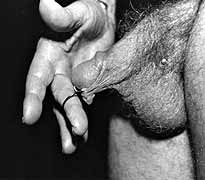 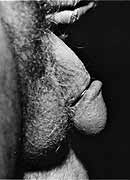 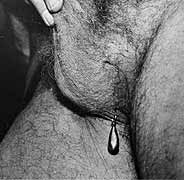
Right: Doug’s Guiche.
Shortly before we met, Doug had written a short autobiography of his piercing exploits entitled The Adventures of a Piercing Freak (click the link to read it). He had subsequently sold the article to a publisher of fetish magazines who issued it in soft cover under the title The Art of Pierced Penises and Decorative Tattoos. Since body piercing was virtually unknown at the time, the publisher was hard pressed to find suitable images to accompany the text. Consequently the photographs used had nothing to do with the story. Piercing Freak could hardly be described as great literature. It is told in a bold style with a certain hyper-masculine bravado. Although I think it largely failed, it was clearly intended as “one-handed reading” for a primarily gay fetish market. Fantastic as parts of it are, Doug insisted the story was true. It’s difficult to believe it was commonplace for divers to use Prince Albert rings to attach an external catheter or that there was actually a college organization of Jewish men advocating Dydoe piercings to restore sensation for circumcised males. Doug did author, to some extent, promotional material for Gauntlet and articles for Gauntlet’s magazine Piercing Fans International Quarterly. The truth is I was the ghostwriter for these working from notes that he provided. One of the first promotional pieces we did was a flyer entitled “Body & Genital Piercing in Brief” (click the link to read it). It contained short histories and descriptions of a dozen piercings Doug considered “traditional.” I drew the illustrations to accompany them. The piercings included were:
Of particular interest is the fact that, with the exception of the navel, all of these piercings have a largely sexual purpose. This reflects Doug’s primary interest in body piercing as a means of enhancing erotic sensation. The impact the “Piercing Brief” has had is phenomenal. It was widely distributed and reprinted and contained many of the colorful myths that persist and, to some extent have been widely accepted as fact. There has never been any proof to substantiate, among other things that:
The evidence on which Doug based his Roman Centurians claim was a Baroque statue he’d seen in Versailles. He showed me a photograph. I pointed out to him that Roman military men frequently wore metal breastplates sometimes sculpted to resemble a muscular male chest. The rings with cape attached were in the breastplate, not the man. Doug paused for a moment to ponder my observation, then replied, “Well, it makes a good story anyway.” There are actually very few body piercings which have a documented history. The most extensively written about is the Ampallang, which at one time was fairly common in the areas surrounding the Indian Ocean. There is one sole reference to the Apadravya that I am aware of and it is in the Kama Sutra. Doug maintained that the Ampallang was horizontal through the head of the penis and the Apadravya vertical. Piercer and researcher Paul King of Cold Steel in San Francisco maintains that the piercings are in fact one and the same and that either one could be oriented in either direction. Whatever the facts, most piercing enthusiasts have accepted Doug’s designation. Less extensively documented are foreskin piercings. We do know that they were performed as part of a procedure called infibulation. Usually it was done to male slaves as a means of enforcing chastity. Women with pierced labia can also be infibulated though the documentation of the procedure is scarce. I sometimes wonder if people into piercing today have any deep appreciation of the tremendous impact Doug Malloy has had on their lives. Certainly he had predecessors and contemporaries equally as passionate about piercing as he, but what was it that made him the center from which the whole modern piercing movement sprang?
I think there are several reasons. For one, no one before him had ever presented such a broad palette of piercing possibilities complete with history and lore. It didn’t matter that he probably made up a lot of it, if not the piercings themselves. He’d at least done enough experimentation on himself to have some sense of their feasibility. This made it possible for him to speak with a confidence that leant great credibility to what he said. It didn’t hurt that it was a message a lot of people were waiting to hear whether they realized it or not. It was also fortunate that Doug didn’t pursue his passion completely in private. Although he was extremely secretive about it, particularly with his family and non-kinky friends, he nonetheless reached out to other piercing enthusiasts who would go on to spread his message. Finally, regardless of how primitive they might have been, Doug had formulated some basic but usable piercing techniques that, for the most part, could be applied by anyone. If you combine all these elements with his good fortune of being in the right place at the right time, you can begin to see the seed that would grow into the modern piercing movement and appreciate how Doug vastly enriched your life. Next: Gauntlet’s Jewelry Design Legacy
Copyright © 2004 BMEzine.com LLC. Requests to publish full, edited, or shortened versions must be confirmed in writing. For bibliographical purposes this article was first published March 15th, 2004 by BMEzine.com LLC in Toronto, Ontario, Canada
|
 |
-
Who Was Doug Malloy? [Running The Gauntlet – By Jim Ward]
Written by
-
COINTELPRO Tactics and the Elimination of the Tattoo Menace [The Publisher’s Ring]
Written by

COINTELPRO Tactics and the
Elimination of the Tattoo Menace
“When truth is discovered by someone else, it loses something of its attractiveness.”
– Alexander SolzhenitsynSome people tell me that the problem with BME is that it’s very “us and them”. It’s true. There’s a strong separatist movement on BME, and when it comes down to it I don’t trust people without body modifications. I’ll even go one step further — I don’t believe that people without body modifications are really even fully birthed and evolved humans, because I believe that communication, expression, and self-improvement are core to what a human is, and I believe that body modification (in one form or another, including everything from body building to transhumanism) is the purest form of these traits.
There’s an old saying that the difference between people with tattoos and those without is that those with tattoos don’t care if you have tattoos or not. I’d like to expand on that by adding that the difference between people with tattoos and those with fake tattoos is that those with the fake tattoos are losers that are not only making themselves look like idiots, but make real tattooed people look bad as well.

A lot of people have been sending me links to the site above (www.sleevesclothing.com), a new business venture by the folks at Tinsley Transfers, a temporary tattoo company. Basically they’re flesh-tone shirt/stockings with high quality prints of large tattoos on them. Unlike fashions that simply co-opt tattoo designs (which I have no fundamental problem with, and think is flattering), the goal of these is to actually make it look like you have large-scale tattoos — it’s a costume. I’m certainly not doubting the quality of their product technically — it looks quite well made. However, when you’re talking about an “I’m an idiot” sign, quality really isn’t your core problem.
At it’s most basic, shirts like these show a fundamental lack of respect for people with tattoos. It’s basically stealing tattoo culture in a way that would be no better than stealing the religious icons of another faith and turning them into some sort of disposable pop culture reference (an ironic analogy given that this is one of the sins of the tattoo community in many people’s eyes).
To me the issue is in the conversion of a permanent message into a transient message (to say nothing of the elimination of the “message of the message” altogether) — the exchange of commitment and loyalty for transience and whoring. Most people with tattoo sleeves take them quite seriously. After all, they’re there for life! Sleeves shirts on the other hand can be taken off, discarded, and swapped for another one as easily as any t-shirt, and because of their “it’s better than a real tattoo” stance it’s a slap in the face of anyone with genuine tattoos. Not only are they being crass and ignorant, but people wearing these shirts are making the public statement that their definition of self is a deception (ie. “I am a lie; I am not what you see.”) — and that tattoos are a part of that lie.
The fact is, the type of expression you get from fashion is fundamentally different than the type of expression you get from tattoos. Tattoos say “not only do I believe in this message, but I AM become this message,” whereas images on a piece of clothing (or makeup) simply say “here’s the lie of the day” — at best they are decorations without meaning or value, part of an elaborate social bluffing game. Now, maybe you’re asking why I have to take this all so seriously, why does it matter if someone likes the way tattoos look but doesn’t want to actually have them? The reason it matters is because they are stealing and then damaging — the only reason they “look cool” is because of the hip cachet that we (the tattooed people) have created by the way we collectively lead our lives. They want to be us, but they don’t have the commitment to be us. It’s not so much that they don’t have a right to share that look, it’s more that they don’t have a right to destroy it through devaluation (as they take a permanent fashion and turn it into the
looklie of the month).In any case, these shirts are incredibly lame, and even if the fashion world loves them briefly, they’ll be spit out as the remnants of a now uncool trend a few months later… tagging all tattooed people with that brush as they fall — after all, if fake tattoos are passé, how lame are real tattoos?
Now, I promised you this was going to be about COINTELPRO tactics and the elimination of the tattoo menace. COINTELPRO was an FBI program between the 1950s and early 70s that sought to “neutralize political dissidents”. This included everyone from communists, socialists, and union activists to influential anti-war and pro-civil rights celebrities like Jane Fonda and John Lennon, the Black Panthers, the KKK, the Yippies, and so on. One of their most effective strategies, far more effective than assassination and more brutal suppression, was simply to discredit. Instead of killing the speaker, or logically debating their politics, they simply used media actions to paint them as buffoons (watch Steal This Movie for a decent fictionalized account how COINTELPRO eventually pushed Abbie Hoffman to “suicide”).
Being painted as buffoons is what these “Sleeves” shirts do, and it’s a growing media trend when it comes to the coverage of tattoos. Take a look through the BME newsfeed and you’ll regularly see articles on people regretting their tattoos (or other mods) and having to get them removed in shame. Here’s a sampling of headlines:
- Tattoos: Decoration or tacky?
- Tattoos that are not for life...
- Geri Halliwell removes old tattoo
- Americans Likelier Than Italians to Regret Decision to be Tattooed
- Doctor Removes Obsolete Tattoos
- Think before you ink: Tattoo removal on the rise
- Christina Aguilera removes most of her piercings
The casual mainstream reader gets the impression not that tattoos are dangerous or “underground” in some way, but instead that they’re simply a stupid mistake, and that people getting them regret it because tattoos are lame and become dated fast. Basically, the current media premise is that tattoos are for buffoons — prompting a friend of mine to make a sign for the door of his new tattoo studio reading “if you’re not a criminal or a drug addict, you’ve come to the wrong place.” In the past, tattooed people were frightening, but these days they’re simply pathetic and laughable… or so the media would have you believe.
In my last column I pointed out that the best way to get young people covered in tattoos is to tell them they’re dangerous, edgy, and underground. Conversely, the best way to get them away from tattoos is to try and trick them into thinking they’re lame and less meaningful than they actually are — and that’s why we need to worry when we start seeing these COINTELPRO-type tactics being used. Now, I’m not proposing that this is some grand conspiracy where some secret anti-tattoo illuminati is meeting to orchestrate this whole thing. The media is doing their normal coverage cycle where something goes from scary to cool to mainstream to lame to forgotten, and the fashion world is simply latching onto that to try and make a quick buck. But when it comes down to it, it’s the attack’s end result that we need to worry about as much as the motivation or lack thereof.
So how do we make this a non-issue?
I suppose the simple answer is that we need to put outlaw culture back into tattooing. So if you’ve got a tattoo, make sure you kick someone’s ass at least once a week — preferably while you’re rip-roarin’ drunk — and do at least a little prison time.
Seriously though, some people have suggested that it’s quite wonderful that the mainstream has gotten into tattooing with such gusto. In some ways I agree, and it’s been wonderful to watch so many human flowers bloom. Additionally, the mainstream attention has resulted in a lot of money flowing in this community and great things are happening because of it. But the mainstream is fickle and looking at even just the last forty years of Western history, it’s obvious that the mainstream’s sensibilities shift radically every decade or so… and we’re starting to approach the end of the “tattoo decade” in terms of mainstream acceptance. It’s possible that we’ve hit a threshold where there’s no going back (15% of Americans are tattooed), but we’re still a tiny minority when you look at it objectively, especially when you only consider those that are heavily or publicly tattooed.
Tattooing as expressed by Western culture is nearly unique historically in its level of variation. No other culture in history that we know of has allowed for this depth of personal expression (indigenous cultures usually used tattoos to emphasize social structures and offered little in the way of personal variance). Not only for our own good, but for the good of the human race, we must embrace this individuality and fight anything that tries to commodify it and make it mundane. Tattooing should be an expression of self; a carnal message rather than some banal false-individuality of a temporary mask. Maybe the truth of the matter is that most people simply don’t have anything to say (but desperately want to), so they are drawn to this “prepackaged mass-produced individuality” that mainstream tattooing (and fake tattooing) gravitates to. Maybe the mainstream drones can’t appreciate the meaning of tattooing, because they don’t have a meaning themselves?
Keep your tattoos real and believe in them. Get your tattoo, not someone else’s. Like the ancient gods, tattoos gain their power from faith, sacrifice, and belief. Tattoos are power sigils, personal magic that can help rocket a person to their full potential. They’re not buffoonery, and they’re most certainly not something you can take on and off like makeup or clothing.
The mainstream never got it, and they never will.

Shannon Larratt
BMEzine.comNext column: Applications of body modification in modern magick.
Photos of “Sleeves” clothing (including cover image) property of Tinsley Transfers Inc. (http://tinsleytransfers.com/), reproduced under fair use doctrine.
-
Tattooed People Onstage: From Exhibitions to Entertainers. Part I
Written by

Tattooed People Onstage:
From Exhibitions to Entertainers.
PART I
“The love of beauty in its multiple forms is the noblest gift of the human cerebrum.”
– Alexis CarrelThe modern Western perception of tattooing has been indelibly marked by its cultural association with the sideshow and its historical predecessor the traveling exhibit. Tattooing as an art form cut its teeth and developed in the West in great part due to the desire for and profit to be had by exhibiting tattooed people. At many circuses and carnivals one could not only see a tattooed marvel but also receive a permanent souvenir from the traveling tattoo artist on the lot. For years, tattoo artists commonly spent most of their time on the road with such shows, possibly also serving as its banner painter, and then wintering at a street shop location. A great example of such an artist, and an inspirational tale in its own right, is Stoney St. Clair whose life and work was documented in what is often considered a seminal work in the history of tattooing: Stoney Knows How (BOOK, VHS).
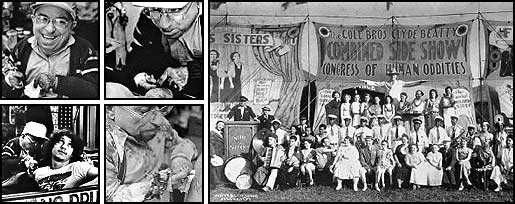
In this column (and part II) I am going to attempt to cover centuries of tattooed exhibits and performers. Chronicling how we have come from natives brought back from expeditions to their native land to our current age where performers such as myself, ThEnigma and Katzen, Lucky Rich, and many more have chosen to tattoo their bodies and exhibit them as part live shows.
In AD 325 Constantine, whose name would later be used by a tattooed attraction in a sort of poetic justice, banned tattooing in the Roman Empire. In AD 787 Pope Hadrian I issued a papal edict against tattooing. Of course, this did not stop the crusaders sent by later popes to wage war for the holy land from getting tattooed while there. However, for the most part these and other similar laws issued forth reflected a general Western prejudice that had developed in the culture against tattooing. Many alleged “experts” considered tattooing to be a sure sign of people being uncivilized and particularly savage. And it was with just such “savage” peoples that exhibitions of tattooing began to gain prominence.
In 1691, Giolo (or Prince Giolo) was taken by William Dampier in settlement of a debt. Dampier fixed upon the idea of exhibiting the tattooed Prince. The marketing for Giolo created a sensation in England, but the exhibition was ultimately doomed as Giolo came down with small pox and died shortly after arriving from the Philippines. Despite the exhibition not meeting expectations, the successful marketing drew attention and many people realized the potential profit in exhibiting native peoples and particularly those with tattoos.
In 1774 a South Seas islander from Tahiti named Omai returned to London aboard a ship from one of Captain Cook’s expeditions. Omai had only minor tattooing, mainly on his hands, but the fact that he was tattooed was a major part of his marketing and often exaggerated. Playing the role of the ‘noble savage’ Omai was incredibly well received and successfully toured most of England, including a royal audience. In 1776 he returned home.
With the success of these exhibits it was only a matter of time before Westerners themselves would hit upon becoming the attractions. Many sailors made efforts to exhibit their ‘souvenir’ tattoos but the standard for non-native exhibits would be set by a man named Jean Baptiste Cabri.
Cabri was discovered in 1804 living among the natives in the Marquesan Islands by George Langsdorff. Cabri, a French deserter, had ‘gone native’ and been extensively tattooed while living on the islands. Returning to Russia with Langsdorff, Cabri not only exhibited his tattooing but also told exaggerated tales of his life among the natives, effectively moving into performance and creating the archetype that would be followed by tattooed people for centuries to come. With good initial success he was able to successfully tour Russia and much of Europe. However, by 1818 his notoriety had declined and he had died in his native France.
After Cabri came Rutherford in 1828. John Rutherford, the first extensively tattooed English exhibit, returned to Bristol after having left for New Zealand in 1816. Rutherford was heavily covered in Maori tattoos and spun fanciful tales of shipwreck, abduction, and living with the natives. Rutherford was able to better capture the imaginations of his audiences than Cabri and further developed the basic elements and progression of the tales that would be mimicked by other tattooed people for more than a hundred years.
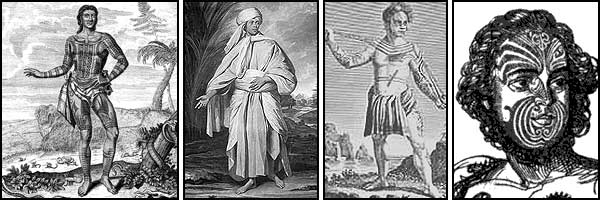
L-R: Giolo, Omai, Cabri, and Rutherford.
As it was in Europe, so it went in the U.S. The first tattooed person believed to have been exhibited in the states is generally held to have been James F. O’Connel. O’connel appeared at Barnum’s American Museum in 1842 telling tales similar to those of Cabri and Rutherford. He published and sold copies of his adventures under the title ‘The Life and Adventures of James F. O’Connel, the Tattooed Man, During a Residence of Eleven Years in New Holland and Caroline Islands’ (1846). While many attribute his appearance at Barnum’s Museum to mean that Barnum was the first to have a tattooed exhibit, there is evidence to suggest that he was already in residence before Barnum took over the museum and several exhibits from Dan Rice.
In 1873, O’Connel was succeeded by Prince Constantine (like the pope) in Barnum’s show. Constantine was a Greek man also known as Alexandrinos Constentenus aka Djordgi Konstantinus aka George Constantine and Captain Constentenus. He was very likely the most successful exhibit to date and for some time, commanded a salary of $1000 a week while also making good sales on his own book of adventures. This success was most likely due not only to his talent for spinning yarns but even more so for the quality and extensive nature of his tattooing. Constantine was covered with finely detailed Burmese style tattoo work. He is also notable for probably being the first person to completely tattoo their body with the specific goal of becoming an exhibition in mind. In the years to come many would follow his model. And, future exhibits were not the only ones he would inspire – it is said that the legendary tattoo artist Charlie Wagner was so struck upon seeing Constantine that he set out to learn to tattoo. This resulted in his finding an apprenticeship with James O’Reilly, who patented the first electric tattoo machine.
With Constantine we enter into what might be called the golden age of the tattooed exhibits. A time when hundreds of people got tattooed and made their living as part of traveling shows and museums. Also, the time in which we see the tattooed women come to the stage and even eclipse the men. This era, the decline of the traveling shows, and the return of the tattooed exhibit as performer in the modern sideshow renaissance will form the second installment of this two part column.
Selected Sources and Suggested reading:
Stoney Knows How; Leonard L., St. Clair
The Art of the Tattoo; Ferguson & Procter
Freaks, Geeks, & Strange Girls; Johnson, Secreto, Varndell
Freak Show; Bogdan
Modern Primitives; Vale & JunoMuch of the original research and work for this column was also used for the BME Encyclopedia which contains a number of entries related to and expanding upon the information presented here.
 Erik Sprague
Erik Sprague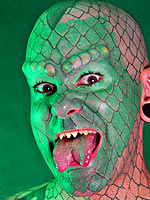
because the world NEEDS freaks…
Former doctoral candidate and philosophy degree holder Erik Sprague, the Lizardman (iam), is known around the world for his amazing transformation from man to lizard as well as his modern sideshow performance art. Need I say more?
Copyright © 2004 BMEzine.com LLC. Requests to republish must be confirmed in writing. For bibliographical purposes this article was first published March 9th, 2004 by BMEzine.com LLC in Toronto, Ontario, Canada.
-
If tattoos are cool, DIY tattoos are even cooler, right? [The Publisher’s Ring]
Written by

If tattoos are cool,
DIY tattoos are even cooler, right?
“All men are frauds. The only difference between them is that some admit it. I myself deny it.”
– H.L. MenckenThe media has been full of stories recently warning parents and teens about the dangers of home-made tattoos, but they fail to realize what’s going through the minds of teens when they see these stories. Instead of discouraging do-it-yourself tattoos, these articles make them even more desirable.
The man: Do-it-yourself tattoos are dangerous and look bad.
Teen: Tattoos? Cool!
The man: Maybe you didn’t hear me. They’re dangerous.
Teen: My middle name is danger. Bring it on!
The man: They look bad though. Look at this tattoo!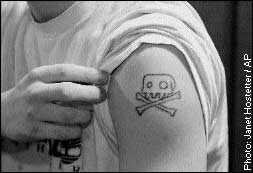
Teen: If by “bad”, you mean “BAD ASS!” See you later dad, I’m going to my room… to get a tattoo.
So basically these articles tell kids that tattoos, especially DIY tattoos, have an underground or outlaw status, and then top it off by showing the kids a super-cute skull and crossbones tatty as a “warning”. If I was still a teen, articles like these would make me head out to the garage and take file to coat hanger to make myself an impromptu tattoo torture device and then scrawl out some hip little icon on myself.
But lets look at the truth of it instead.
When I was a teen I was enamored with tattoos. While he was in college, my father won a panther tattoo in a wrestling match and I remember how proud I was to show it off to all my friends at school. As a teen I thought tattoos were tough — signs of manhood — and they appealed to my sense of rebellion and individualism. After little to no planning I went to a pharmacy and bought a small box of insulin syringes, after which I went to an art store and bought some India Ink. Sitting on my bed, I drew a one inch by five inch “tribal” design on my bicep with a blue ballpoint pen. I filled up one of the syringes, pushed the plunger a little to form a bead of ink on the tip of the needle, and began poking the tattoo into my arm. Every time the ink was used up I wiped my arm clean, pushed some fresh ink from the syringe, and kept going. Within half an hour the small tattoo was complete. Within a week I also had a small Eye of Horus on my shoulder and a cat skull on my calf.
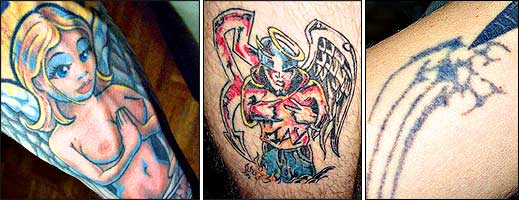
Good, bad, and terrible tattoos. Which do you want?After a brief period of showing off though, the coolness was gone and I was left with three crappy tattoos. The first still takes up valuable real estate on my bicep (you can see it above-right), and is complicating getting a proper sleeve done. After taking a high school art course as rehabilitation made him consider a career as a tattoo artist, the second was covered up with a dragon by a friend who had recently been released from prison. That cover up was later covered up again, and I now have a huge blob of scarred up color on my shoulder that I don’t know what to do with. The third was covered up with a thick black band around my calf and shin.
The problem with teens’ thinking isn’t that they’re ignorant or short-sighted. The problem is that teens are excited and full of life and tend to be impulsive, especially when adults dangle carrots of cool in front of their noses like these articles do (and like buddies with needles and ink, as well as unscrupulous scratchers, are more than willing to facilitate). Now, personally I have an agenda to see as many tattooed people in this world as possible, but really, I’d rather if they had good tattoos that they’re happy with in the long run!
So here’s my advice to young people who want tattoos:
1. Your tattoo is a reflection on you.
Not only is the subject matter of your tattoo going to communicate with the rest of the world what you stand for and who you are, but so is the quality. A bad tattoo is like dirty unwashed clothes that don’t quite fit right, but are stuck on you for life — or like an essay that hasn’t been properly proofed for spelling and grammar… It just doesn’t communicate its message well. The effort you put into getting a high quality tattoo is a direct reflection of what you think about yourself and how much you care about yourself.
A bad tattoo might make you look tough to people who are suffering under the stereotype that criminals and tattoos go together — in fact, the worse the tattoo is, the more likely they are to assume you’ve “done time”. But is this really something you want? Some sort of mock balls? All that’s going to do is make you look like a fool to people who actually have been in prison, and make the rest of the world look down on you (especially when they realize that you’re faking it).
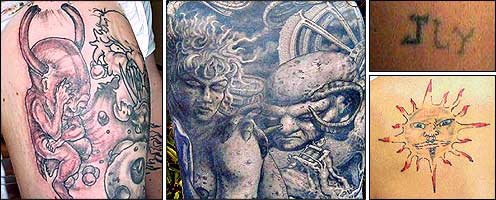
2. If you’re too young, suck it up and deal with it.
The unfortunate truth is that if you’re under 18, the vast majority of reputable tattoo artists on this planet will not tattoo you. That’s not because they don’t think you’re ready for it, or because they have some sort of uppity over-30 attitude toward teens — it’s because they own a business and can’t risk losing it over a violation of some stupid law.
Yes, you will find artists willing to bend the rules. They are out there. But the truth is that they’re not the best artists, and they’re not the artist you should be going to if you want the best tattoo. If you’re underage, take the time to search out the best artists, and when you’ve found one, you can make an appointment for your 18th birthday and work with them on the perfect design beforehand.
3. Save your money and do it right. Go big!
One of the most common regrets people have with tattoos, as with many things, is “I wish it was bigger.” Too many people make the mistake of getting a small tattoo on a large piece of skin. Common mistakes are a small logo on the shoulder, or a band around the arm which later interferes with getting a full-sleeve piece.
A large tattoo is bolder in a graphic design sense, and moves with your body — it becomes a part of you far more than any “patch” could. Additionally, it forces you to think about what you’re doing on a more profound level, and the result is almost always far more satisfactory to both the person wearing the tattoo, and the general public viewing the tattoo.
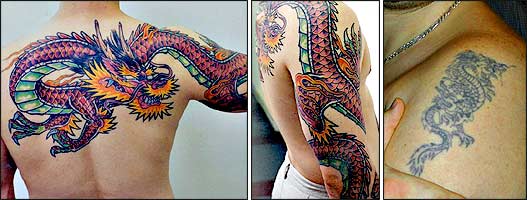
4. Think about it; what do you want to say? Who are you?
If you had to wear one outfit of clothing for the rest of your life, and it had to suit you in all situations that life throws at you, what would you choose? That’s basically what you have to decide when you’re selecting a tattoo.
Try to articulate why you want a given image tattooed on you for the rest of your life. If “because it looks cool” is a good enough answer for you (and it surely is for some tattoos), please consider that “cool” has a radically different definition now than it did in 1975, and you can bet it’ll be different again in 2025… Just remember that your tattoo should be cool in relation to who you are, rather than in relation to what society is at that moment.
5. Educate yourself.
Knowledge really is power. A lot of people make the mistake of getting tattooed at the first tattoo shop they step into, without ever seeing another. This is inexcusable in my opinion. Absolutely inexcusable. Of all the things you buy in your life, a tattoo is one you should definitely do your research on, for one simple reason:
There are a lot of bad tattoo artists out there!
Even ruling out the artists that don’t meet health board approval (want to find someone who will tattoo minors? look for the shop without an autoclave!), there are a multitude of dudes with tattoo machines that are anything but artists. So go to every studio you can and look through the portfolios. Buy tattoo magazines and browse online portfolios and see just how good a tattoo can look.
Looking at the tattoos in this article, can you tell which ones are good and which ones are not? If you can’t, then you’re not ready to be tattooed yet.
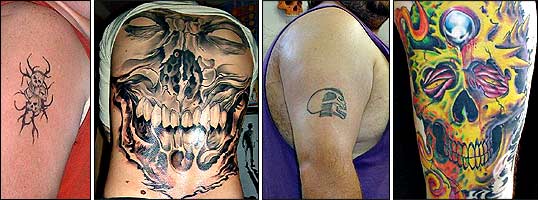
6. Resist the impulse buy.
There are exceptions to all of these rules, but if you want to have a good tattoo that you’re going to be happy with for the rest of your life, here’s how you can be fairly sure you’re making the right decision: don’t get it the day you think of it.
If you can get the artist (or a friend, or yourself) to stencil the tattoo onto you or paint it on, take a picture of yourself with it. You can also do this by drawing it on yourself in a paint program or sketching it onto a photo of yourself. Put this picture by your mirror or by your computer or somewhere that you’ll see it every day — how do you feel about yourself with this tattoo? If it still looks as good to you at the end of six months (or whatever you feel is a good time), then you can be a lot more sure that you’ve come up with something with meaning that you’ll appreciate for life.
The suggestions above are far from teen-specific. If people of all ages listened to them, we’d have a world with a lot better looking tattoos. Perhaps I’m betraying my art school background here, but I really believe the value of a society can be gauged by the diversity and perfection of its aesthetic landscape — so in my world anyway, when you put effort into tattoos, you are being patriotic.
In a twisted sort of way, teens are at a huge advantage when it comes to tattoos — they have a forced waiting period. Certainly many don’t take advantage of this and end up with bad hand poked tattoos followed up by poorly done tattoos by sub-par scratchers like I did… but more and more teens are using this time period to save up the money for a good tattoo (they are expensive after all — $500-$1000 is a good starter budget for a mid-sized tattoo), plan the perfect one for themselves, and go to the best artists. The 21st century is going to be a colorful one, so I hope everyone does their part in making sure the future is as beautiful as possible.

Shannon Larratt
BMEzine.comNext column: COINTELPRO tactics in eliminating the tattoo menace.
-
Advice to Schools and Parents Regarding Body Piercing [The Publisher’s Ring]
Written by

Advice to Schools and Parents
Regarding Body PiercingIt is an illusion that youth is happy, an illusion of those who have lost it; but the young know they are wretched, for they are full of the truthless ideals which have been instilled into them, and each time they come in contact with the real they are bruised and wounded.
– W. Somerset Maugham
-
The Great Fredini Interview – Through the Modified Looking Glass
Written by

The Great Fredini
“If Homer Simpson wants his son to work in a Burlesque house, then Homer Simpson is gonna let his son work in a Burlesque house! Oh! Hi... Marge, now you’re gonna hear a lot of talk about Bart working in a Burlesque House...”
– Homer Simpson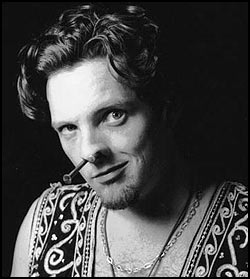
The Great Fredini is a man of many hats — and I understand the rest of his wardrobe is pretty nice too. Onstage he is an MC, a talker, magician (the world’s worst, by his own description), a blockhead, a ventriloquist, and a sword swallower. Fredini also does the Coney Island website design (coneyisland.com) and works with Funny Garbage (funnygarbage.com). And while he no longer regularly performs as part of the Coney Island Sideshow cast, he hasn’t left the stage behind as he now hosts This or That (thisorthat.tv), the resident burlesque show.
Meet Fredini!
THE LIZARDMAN: Let’s start out with the basics.FREDINI: My name is Fred Kahl, The Great Fredini. I’m 38 years old and live in New York City. I’m a sword swallower and currently work as a creative director at a New York Design and Production company named Funny Garbage.THE LIZARDMAN: How did you first get involved with sideshow and Coney Island?FREDINI: I was an art student interested in illusion. I spent a lot of time up at Flosso’s Magic Shop perusing old magic books. At the time I was doing sculptures based on illusion principles — a lot of stuff inspired by Duchamp. I got into performing magic on the street, and through the Flosso connection became enamored with Coney’s history. This was in the early 80’s, at the same time that Dick Zigun’s Coney Island USA was just being established, and the Coney Island Hysterical Society was running the funhouse in Coney.There was a lot of great underground art going on out there and it seemed like the perfect place for me. A few years later John Bradshaw hired me to be in the sideshow and I went for it. I only worked about a month for him because I had an artist-in-residency somewhere that summer, but that was it — I had the bug. The following season, Dick set up his own show and signed me on for the season.
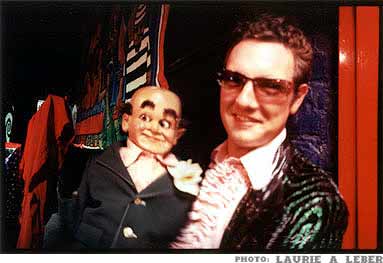
THE LIZARDMAN: Do you have any tattoos or piercings?FREDINI: I have one small jailhouse style tattoo on my foot — it’s of a key, and it’s about an inch long. I’m the straight man in the show.THE LIZARDMAN: You worked closely and were good friends with the late Michael Wilson (who many readers will probably know from his interview in Modern Primitives). He is probably one of the better known and respected tattooed men of the modern sideshow revival. Can you give us a favorite story or moment?FREDINI: 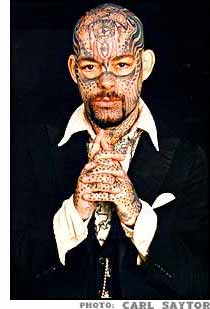
Michael was really an amazing artist — himself being his most famous work, but he was quite an accomplished painter as well. We had a lot of good times together. One of my favorite ways he dealt with hecklers was when they shouted out “take your pants off” or “what’s on your butt?”, to which he’d reply “There’s a rose on my ass, wanna smell it?”Believe it or not he was actually very modest about revealing the tattoos he had down there. He was once on the Robin Byrd Show (an adult cable access show in NYC) and Robin tried to get him to strip down but he refused.
Michael was also the first person I knew with a tongue piercing. Back when he first started hammering a nail through his tongue, we literally had people practically fainting or walking out of the show. Later in his career, piercing got more prevalent and it lost its shock effect.
THE LIZARDMAN: What was your perception of heavy tattooing and piercing before you got into sideshow — has it changed much now that you have worked with and known so many heavily modified people?FREDINI: I remember seeing Captain Don perform at the modern primitives show in Seattle, and seeing Jonathan Shaw at the first tattoo show in Coney and remember being impressed by their tats — specifically the fullness of their coverage. I guess over time I’ve really grown to have an appreciation for the artform and have refined my tastes of what I like best.I really like the old school American sailor flash myself, as well as artists who do contemporary stuff in that style. I keep thinking I’ll get some when I turn 40… But the only way I’d go for it would be to get a big area — a full back piece or sleeves — none of this piecemeal stuff.

THE LIZARDMAN: As a sword swallower, you engage in a very serious form of body control and manipulation, if not modification. Tell us a bit about that.FREDINI: When I fist worked the sideshow, I just did blockhead and magic, as well as lots of ballying. Michael Wilson and I had a competition as to who would swallow swords first. I always wanted him to do it so he could swallow neon. I wanted to call him the human lampshade because of the way the light would go through the tattoos on his neck.At the time no one in the show was swallowing swords, but Michael would say it’s all yoga. During the off season, I started studying yoga, and got really into it. I tried to swallow a coat hanger periodically, but had no success. When the season started, I brought my coat hanger out to Coney. I figured I’d learn backstage between sets. My first attempt in Coney Island worked — and boy was I surprised. That afternoon I began performing it on stage, and by the following week I had a sword.
THE LIZARDMAN: You have children, which in my experience, is a little bit rare for sideshow performers. Did you consider how the sideshow environment might impact raising them?FREDINI: I just do what I do, and they take it at face value. They’ll probably grow up to be bankers in a backlash against it!THE LIZARDMAN: Would you encourage others to learn acts and join the sideshow? Is it a career path you would like to see your children carry on?FREDINI: Like Melvin Burkhardt used to say, “It’s a hard way to make an easy living.”THE LIZARDMAN: What does the word “freak” mean to you?FREDINI: Ugh, I don’t know. People who are mentally and emotionally malformed? Not most people in the sideshow. Michael Jackson is a real freak — both psychologically, and in the self-made freak kind of way.THE LIZARDMAN: You are a guest lecturer at the Coney Island Sideshow School. Tell us a bit about your experience with that.FREDINI: Todd Robbins is the real master of Sideshow School. I just do a little sword swallowing tutorial. We do some breathing and relaxation exercises and try swallowing coat hangers. The old law was that a sword swallower would only ever teach one other person — just to pass the act on, but I guess I’m doing the opposite… teaching more sword swallowers than anyone else! But really, Todd Robbins deserves all the props for Sideshow School.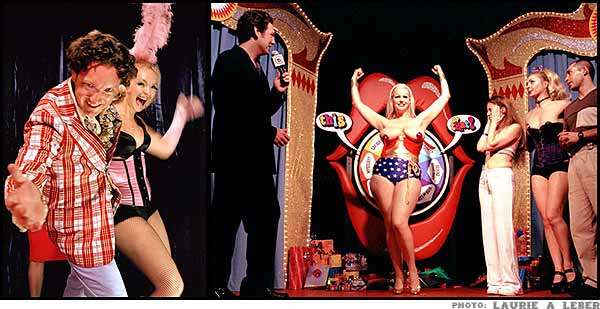
THE LIZARDMAN: Tell me about the Coney Island Burlesque show.FREDINI: For the last seven years, I’ve run the Coney Island Burlesque at the Beach series, which gave birth to my latest project — “America’s favorite Burlesque Game show – This or That!”. This is the TV show I want to see when I turn on the TV! We’re about to start pitching it around at networks. I’m not sure if anyone will touch it, but we’ll see.The idea is that it is a sexy game show — part Gong Show, part Let’s Make a Deal, but hotter. We make the contestants reveal their inner exhibitionistic selves. It’s really just good clean fun (with some skin showing). Along the way there’s some wild variety acts in the show, but it’s really about making the contestants — these “normal” people come out of their shells, and believe me they do! You can’t believe the things people will do to win a vibrator (see what I mean at thisorthat.tv).
THE LIZARDMAN: What was the impetus to do a burlesque show? Was it the historical connection or simply a matter of saying “Hey, you know what people like? Stripping!”FREDINI: Burlesque is an old American artform like the sideshow, so the historical connection was a draw, but face it — sexy girls are a lot more exciting than looking at Eak! (Unless you’re into that!).At Coney Island USA, we had always done an annual Go Go Rama night, and Dick Zigun had written about Minsky’s in the 70’s, so it was something that was in the air out there. The charter of CIUSA is to uphold American popular artforms like the sideshow and tattooing, so burlesque was a natural extension. Plus, it made good money, so in the age of struggling non-profits, it made good sense. When I left the sideshow I
knew I wanted to stay involved out there and Burlesque at the Beach and Tirza’s Wine Baths was born out of it!THE LIZARDMAN: Is it different doing acts like the blockhead and sword swallowing for a burlesque crowd?FREDINI: Not really — the crowd at the burlesque shows is usually all revved up, so in that sense it’s good. At a sideshow you get audiences that span anywhere from super revved up to dead as a doornail, but really, my blockhead and swords routine is pretty much never fail… so there you have it!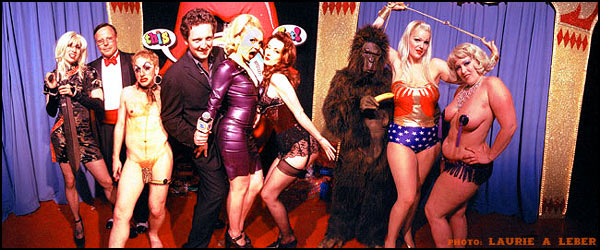
Be sure to visit Fredini online at Coney Island and at This or That.
 Erik Sprague
Erik Sprague
because the world NEEDS freaks…
Former doctoral candidate and philosophy degree holder Erik Sprague, the Lizardman (iam), is known around the world for his amazing transformation from man to lizard as well as his modern sideshow performance art. Need I say more?
Copyright © 2004 BMEzine.com LLC. Requests to republish must be confirmed in writing. For bibliographical purposes this article was first published February 10th, 2004 by BMEzine.com LLC in Tweed, Ontario, Canada.
-
TEETH RULE – The BME Cultural Corner
Written by

Teeth Rule
Alicia Cardenas
When I am working on a problem, I never think about beauty. I only think of how to solve the problem. But, when I have finished, if the solution is not beautiful, I know it is wrong.– Buckminster FullerWelcome back to the BME Cultural Corner. I’d like to introduce my friend and colleague, Alicia Cardenas. She and her partner have operated Twisted Sol (twistedsol.com) in Denver, Colorado for eight years. Alicia is also serving a term as cultural liaison on the board of the APP. She is deeply involved with indigenous groups, and practices and teaches traditional Aztec and Mayan dance, and has a profound spiritual appreciation of tribal cultures around the world. Alicia has recently returned from a trip to Central America where she had had her own teeth modified in the traditional style. Alicia is a skilled piercer as well as self-educated anthropologist, and her fascinating journey to her own tribal origins is now here on BME for all cultural enthusiasts and body artists alike to share. Thank you Alicia,– BlakeThis is the first in a series of articles devoted to the ancient practices of tooth modification. To begin this series, I will tell my own story and invite others to share in my experience. Although I believe the history of these practices is important, the evolution of this ritual and its modern day significance plays a huge part in the widespread acceptance of this truly beautiful display of individuality.
I’m not exactly sure when it occurred to me that I wanted to get traditional gold teeth. I just decided it was pretty and divine, and then came to want them for myself. While growing up I remember seeing people with steel or gold caps, and I would assume they had a bad tooth and that was what they put in its place (teeth being one of those things you tend to notice on everyone, and parents pay thousands of dollars to fix in a quest for the perfect American smile). I understood the concept at a young age of “beauty at the price of discomfort,” a theme that would reoccur throughout my adult life. Beautiful straight teeth were something I fought for throughout my youth, regardless of the discomfort. I wanted to be an actress and for that you needed straight teeth. Headgear, headaches, bleeding gums, wax and rubber bands; it was like some sort of torture. Braces were not a sign of beauty, but knowing the end result was beauty, it became widely socially acceptable to have them. After my battle with braces I swore off dentists for life unless completely necessary — little did I know that my tooth saga would continue (and by choice). I would modify my teeth further in search for beauty and for an understanding of the ancient practices of my ancestors.
American culture is so attached to a specific idea of beauty that it is spoon-fed to us on the cover of every magazine, on television, and in the movies. We can’t (or don’t) want to conceive of the different forms of beauty being embraced by neighboring cultures. One great example of this is tooth modification in Mexico — tooth filing, capping, removal, and incrustation are all comonly practiced artforms among the indigenous people of Mesoamerica. In ancient times, these cultures practiced advanced dentistry far beyond what the “savages” were assumed to be capable of.
These people were far from savages, but an advanced culture that excelled at astronomy, mathematics, body modification, and much more. The Maya were the first to apply this adornment and practice it still. Tribes throughout the body of Mexico that came later in history, such as the Toltecs and Mexicahs (Aztecs) followed in their footsteps. While growing up in America, the only people I saw who had gold or steel teeth were the Mexican population (with the exception of people who had very damaged teeth). Since Colorado has such a large Mexican community, I grew up convinced that Mexicans had really bad dental health — little did I know that most gold caps and gold windows being performed in Mexico were inspired by beauty, and not poor dental health!
As I grew older and realized the significance, I became captivated by it. Seeing people with gold teeth began to inspire me to find a deeper, more universal explanation of why this was a healthy part of human history. Modern Mexicans, Mayans, and other indigenous cultures of South and Central America still practice tooth adornment. Mayans can often be identified by their gold caps, usually on the four front teeth (top or bottom). This tradition was so strong that it has survived for thousands of years. If I was going to get my teeth modified it would have to be with the experts. I would travel to Mexico City in search of answers in my quest for tooth modification.
If you go looking in Mexico City for an answer, you will truly find it.

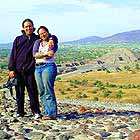
Temple of the Moon.
In a population of twenty million there is always something to learn or do. James (the other piercer at Twisted Sol) and I arrived in Mexico City with nothing but our backpacks and a mission of immersion. We had wanted to travel many times together and had never gotten the opportunity, but now found ourselves in our favorite country and the place of our ancestors. Tenochtlitilan. We were greeted and hosted quite possibly by Tonazin Tlalli (mother earth) and Tonatiuh (father sun) themselves — Ana Paula and Ruso. They have a beautiful body art studio called Tonatiuh (cuerpoadornado.com) in Mexico City, and would be our guides and hosts for this ten-day affair. Looking at these two people you are immediately transported into the past — not only do they look like a page out of history, but they live and follow the philosophies of the ancient people. Having guides like these was a blessing. We would see Mexico like we’d never seen it before. Throughout the entire trip teeth were a reoccurring theme. In each museum we visited there were multiple exhibits with tooth incrustations and statues that had teeth that were filed.


Left: With Alfredo and Ana. Right: With Ana and Ruso from Tonatiuh.
While standing out front of the Museo De Anthropologia we ran into four Maya women that all had all front four uppers in gold and gold windows. I explained my fascination and they agreed to allow me to photograph them (in the photo only one of them smiled enough to show her teeth though). Of the four women only one of them needed the gold teeth because of problems with her natural teeth. This concept would present itself again and again, assuring me that my urge to change my teeth was a normal one.
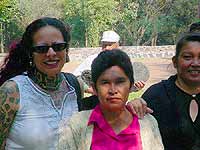
With ladies from the Yucatan.
I had arranged ahead of time to get an appointment with a dentist. Ana warned me that as a board member of the APP, visiting a dentist in Mexico was going to be a hardcore awakening to the realities of cleanliness. I reminded her that the only difference between a dentist in America and one in Mexico is that dentists in America have nicer equipment, but are still just as dirty. I prefered to visit one that had more of a family feel, and had experience with this type of procedure. To my surprise, Ana had an aunt, Pilar, who was a dentist, and I could have an appointment with her. It would require two appointments; possibly three. My first one was to consult with her and really talk about what we were doing. James and Ana helped as I couldn’t understand — my Spanish is very limited and she was using a lot of dental terms.
Pilar was your typical family dentist and was definitely surprised to be asked to perform such an unusual request. Even though it is the style in many rural parts of Mexico and the Yucatan, Pilar was a middle to upper-class city dentist that was more often putting on porcelain caps to fit in with the mainstream, rather than the gold ones which are the style for older generations. She asked why and I told her it was tradition, and she simply mentioned doing incrustations with jewels would take far longer. She also mentioned that it was strange for her to work on perfectly good teeth. I reminded her she was making them better.
I immediately knew when I sat with her that she would be the dentist to do my teeth. I did like the fact that she was a woman. She also seemed to become more and more fascinated with the project as we talked. It was as if she was being reminded that the trade of dentistry was ancient, and she too was carrying on the tradition by performing the procedure. She gave me many opportunities to back out but I became more and more convinced that I was ready to do this, and this was the time to do it.
She began by taking the first and last molds of my teeth and bite — the way they were when I arrived in Mexico. She was very concerned with details and took several impressions to make sure that it was accurate. I must have had a gallon of spit sucked out of my mouth and it was very difficult to hold open my mouth for two hours. She then came at me with a syringe that was much older than I, and numbed only the section of my face necessary to grind down my teeth without pain. She gloved and masked up and ground my teeth down. It took about two hours total. The cleanliness (or lack thereof) only bothered me for the first twenty-five minutes, until I gave in to the experience. Then it was just funny. I am of the strong belief that good intention kills germs*, and in this case it would have to!
* Note: in one piercing I go through eight pairs of gloves. Pilar used one pair for two hours, handling everything in the room. I asked James to take photos, but as these things often happen, I had one bag not arrive back in Denver and it was the one with all the film in it… so I have only the photos James took on his camera.At the end she fit fake plastic teeth called provisionals over my new stubs. They looked just like oversized teeth except they were only there to protect my stubs from causing me pain from their sensitivity. I would wear the provisionals for three days until my new gold caps where made, having them fall off every time I ate and making me feel like Goofy. The next few days were a surreal period of reflection, as it was too late to turn back, but I was not there yet.

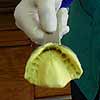
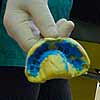

Before the operation, making molds, and the ancient syringe.
The final appointment would be the day before we were scheduled to leave. It was very important that everything went well in getting the gold ones made because I would have to extend my trip if they didn’t fit.
When I arrived back at the office to get my new gold caps I was so excited I felt as if I had been without a part of my body I was about to get back. As she fit them on I knew everything had gone great and I would be able to leave with them in place. Pilar had become obsessed with their perfection and she was worried, not so much if I liked them, but more if she thought they were perfect. In the small amount of time we shared together she was no longer a stranger but like a part of my extended family in Mexico. She would be in my memories as a fine practitioner of an ancient art forever. With some minor adjustments I was reborn. My smile could have not gotten bigger! It would take a few weeks before I stopped tonguing them and wishing I had made more time for an incrustation but eventually I would acclimate. What I could not stop thinking though was how the ancient ones did it and why.
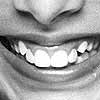
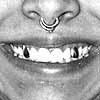

Before and After.
The quest for beauty and status was definitely a motivating factor but certainly not the only reason why teeth were modified. In Pre-Columbian Mexico teeth were not only adorned with gold and precious stones (jade, obsidian, hematite, turquoise), but they were filed, stained, notched, and even removed and used in other adornments. Often conch beads were made in the shape of teeth and strung together with jade and coral for large ceremonial necklaces. These items were reserved for royal death offerings. The teeth themselves were a symbol of much more than just physical aesthetics. They symbolized strength and would survive into the afterlife, unlike flesh.
The removal or notching of teeth was done to represent devotion to deities and had special meaning (it was not given out to just anyone). There are many spiritual significances and rituals that surrounded these practices, but when medicine men or shaman performed them, they used virtually the same techniques as are used today — tight fit or cements. However, today if an inlay is done it would require an artificial cap being inlayed and then placed over the tooth (or in place of the tooth), whereas the ancient people did inlays in teeth that were still healthy and attached, making the procedure much more difficult than the one modern dentists usually use.
What I identified most with in these ancient practices was that they were used as a type of medicine to cure a different kind of ailment. For me there was medicine in getting my teeth worked on. It lightened my spirit and brought me a new found love of a once dreaded part of my body. After all the years with braces, my teeth were never perfect, and I often neglected to give teeth-baring smiles. My gold teeth now overshadow any insecurity I ever had about smiling as big as I can. Simply by having them I am setting an example of ancient traditional beauty in modern culture and how adorning teeth is not only about fixing something that is broken, but adding to something making it even better.
My studies have gone on to all continents in search for all the explanations given for this type of bodywork. I have begun to collect and catalog each case of tooth modification done in history and today. I look forward to presenting an article on each continent and the modern day stories of tooth adornment. Thank you to my friends James, Ana, and Ruso for guiding me through this experience. Without them I would have not been able to get them done. Thank you as well to Blake, for planting the seed and helping it grow.

Alicia Cardenas
twistedsoldier at hotmail dot com
-
The Gift of Magnetic Vision [The Publisher’s Ring]
Written by

The Gift of Magnetic Vision Maybe technology eventually turns them into something that we wouldn’t call human. But that’s a choice they make — a rational choice.
– Bruce Sterling, SchismatrixIt’s hard to deny that Steve Haworth (iam:steve haworth) has been one of the most influential and innovative voices in body art over the past decade. In the field of implants as sculptural art he has singularly defined the art form, and with the assistance of Jesse Jarrell (iam:Mr. Bones) has continued to escalate it into increasingly refined forms. I heard a rumor recently that they’d been experimenting with magnetic implants, and I thought to myself, “cool party trick”, and checked out the pictures on Steve’s page.
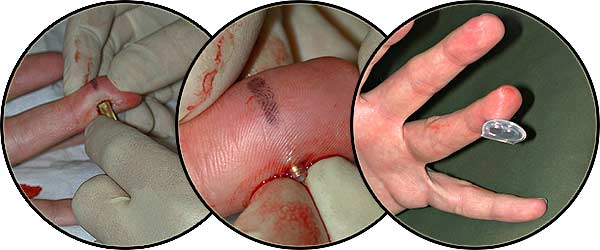
Photos of Todd’s implants being inserted by Steve, and showing them responding to a magnet.
Photos courtesy of Steve Haworth and Jesse Jarrell.A fascinating letter from the client was posted along with it — he’d had a small silicone-coated neodymium magnet implanted, and it turned out to be far, far more than just a party trick!
Sensory Experimentation Somatosensory Extension
Reflections by Todd M Huffman [excerpt]I am now able to perceive magnetic fields in ways not naturally possible. The sensation is different than holding a magnet, as the neurons are stimulated with a higher resolution. With the implant I can detect subtle changes in polarity and strength that I cannot when equipped with a magnet in the conventional manner. Yet the most significant observations have come from another property of implants, their relative permanence to exogenous artifacts. Being able to perceive magnetic fields has expanded my conscious perception of magnetic fields ‘in the wild’.
In one sensory incident, I was walking out of the library, and I sensed the inductive anti-theft device. I have walked in and out of dozens of libraries hundreds of times, and never once have I thought about the magnetic fields passed through me to prevent me from stealing a book. I have been intellectually aware of the mechanism, but never paid attention until now. Another time I opened a can of cat food for my girlfriend’s pets, and I sensed the electric motor running. My hand was about six inches away from the electric can opener, and I was able to sense where the motor was inside of the assembly. Again it brought my attention to a magnetic source that I understood intellectually, but would have otherwise been unaware of. I feel I am one step closer to fully grokking the reality I inhabit.
The experience of my implant is not nearly as rich as my visual or auditory sensation, but nevertheless after a week it has dramatically changed the way I think about my daily sensory experience. A small magnet embedded in a finger may seem like a trivial exercise. I find it difficult to explain the significance, somewhat akin to trying to explain to a blind person what it is to see. The problem isn’t defining the technical characteristics of the visual system, but one of trying to convey what conscious perception of certain wave frequencies does to the way a person conceptualizes the world.
In modifying my body I have ever so slightly altered the way I organize the world in my mind. I eagerly await the day in which I can integrate more elaborate senses into myself. With every passing minute I try to see radiant heat, hear radio waves, and think the thoughts of those that pass by. And by better understanding what I cannot feel, I can fully appreciate what I have now.
I was floored. This seemed to me to be one of the biggest steps body modification has taken. The notion of enhancing sensation is nothing new to anyone with genital modifications, but the idea of adding something fundamentally new to the function of the body is a radical concept that only a few people have done meaningful experiments in. I had to interview Todd about his experiences, and he was happy to help us out.
BME: Tell us a bit about yourself… Where are you from?
TODD: I grew up in Los Angeles and a small town, Teutopolis, in southern Illinois. When I was growing up my main interests were in emergency medicine. I started college studying nursing, with plans to continue on to medical school. While in high school I got my certification as a Nurses Assistant, and completed a course to be an EMT. These experiences are relevant because I was very thorough in my research on body modification, the effects of magnetic fields on tissues, implant construction, and the specific procedural skill of Steve Haworth (the implant artist who worked with me on the project).
I worked as a nurse’s assistant in the St. Louis University Hospital Neurology unit, where I developed my interest in neuroscience — and my aversion to medicine. I don’t dislike the medical profession per se; I just prefer an occupation with more freedom. I moved back to California to attend California State University at Long Beach and studied neuroscience. After graduation I took a job with the Alcor Life Extension Foundation (alcor.org), and will be working there for two years until I start graduate school.
One important aspect of my life is transhumanism. I have been identifying myself as a transhumanist since the age of thirteen, when I discovered the website of the Extropy Institute and the philosophical writings of Max More (maxmore.com) and Nick Bostrom (nickbostrom.com), among others. The transhumanist philosophy has provided a useful framework for me to build ideas and concepts upon, such as the concept and practice of attempting to extend my sensory experience.
BME: Did you have other modifications before this particular “upgrade”?
TODD: Before this my body modifications have been limited to piercing, both cosmetic and play. Our society has perfected the art of pain avoidance and disassociation from our bodies. Piercing and other body modifications bring the mind back to the body and increase a person’s awareness of their physical self. For such a materialistic society, America has lost touch with their physical self.
BME: So this the first “functional” modification you’ve gotten?
TODD: Yes. The magnetic implant is probably the crudest form of functional implant. It pales in comparison to much more complex implants that interface directly with neurons, such as cochlear implants. As a point of clarification, my magnetic implants are more effective as a conceptual tool, rather than for real world use. The plans were more for the exploration of sensory experience than for a specific task that would increase my functional abilities.
BME: For those that aren’t familiar, could you tell us a bit about cochlear implants?
TODD: Cochlear implants are a medical device that bypasses damaged structures in the inner ear and directly stimulates the auditory nerve, allowing some deaf individuals to learn to hear and interpret sounds and speech.
My involvement with cochlear implant research was analyzing the electrophysiological brainstem response of implant patients with a particular disease, auditory neuropathy. I did this for a semester as an independent project, and the bulk of my time was spent in front of a computer working with numbers. However I did on several occasions assist in the data collection procedures, and talked with people who had cochlear implants. I was fascinated with the possibility of gaining a sense with technology that was forbidden by nature.
Fortunately I have all the senses normally accorded to a human being. Current medical devices are not capable of giving me additional sensory experiences. Steve Haworth, Jesse Jarrell, and I were discussing various implants, and Jesse mentioned a friend of his who got a steel sliver in his finger and could sense speaker magnets. Jesse and I had previously discussed implanting magnets, and the idea was born. I was highly motivated to get the implant because of the possibility to explore a new sensory modality.
BME: How did you refine the idea into something functional?
TODD: I spent several months researching magnetic implants. I was concerned the magnet would attract iron particles from degraded red blood cells and cause irritation in the surrounding tissue. A significant amount of research has been done by the medical field and my concerns were alleviated. After that Jesse and I ordered a batch of neodymium magnets from a supplier and played with size combinations. After determining the sizes and shapes of the desired implants, Jesse made several prototypes. Jesse and I tested the implants to make sure the coatings were sufficient, and Jesse made the implant that was actually implanted.
BME: How was the healing?
TODD: Healing was great. I had feeling back by the next morning, and full sensitivity back in a week. The scarring is minimal, and is not noticeable unless you are looking for it. The next day my finger felt like I had slammed it in a car door, but that is expected. There has been no prolonged discomfort.
BME: Is the implant visible?
TODD: Not visible at all. If someone palpates my fingertip and knows exactly where the implant is they can feel it. A friend of mine couldn’t find it until I pointed out the location.
The goal was to have it as unobtrusive and natural as possible. The reason for this was not to hide the implant from other people, but to hide it from myself. I want the sensation to seem as naturally endogenous as possible. I want the sensation to integrate as much as possible with the rest of my sensory experience.
BME: How does it feel to you in the absence of a magnetic field?
TODD: I feel nothing, just like any finger experiencing normal conditions. Humans ignore the majority of sensory experience, a necessity given the barrage of information thrown at us by reality.
BME: And when you move into a magnetic field, what does it feel like?
TODD: There are two distinct feelings I get from fields. For a static field, like a bar magnet, it feels like a smooth pressure. Imagine running your hand slowly through lukewarm water, and brushing your finger across the top of a large invisible marshmallow. That is the closest description I can give. Oscillating fields, such as electric motors, security devices, transformers, et cetera, vibrate the magnet. This sensation is much more sensitive and noticeable.
BME: How sensitive is? Can you tell the direction of a field?
TODD: The implant is rather sensitive. I can tell the polarity of a bar magnet from several inches away. So far the furthest I have felt an oscillating field has been about two and a half or three feet. That was the security system in a video store, which uses magnetic induction.
BME: You can “feel” for anti-theft devices? You’re getting all the super-villains excited!
TODD: All you would-be criminals don’t get your hopes up. I can only detect the active components of anti theft devices — those stands by the exits of stores. The actual component inside the item does not generate its own field. I just get a buzzing feeling when going through security systems.
BME: How “fine” a sense is it? Does it feel like a sense like sight or hearing, or more like a “sixth sense” in that it’s more of a “gut” or instinctual sense?
TODD: The feeling is rather fine. I can detect different frequencies in the magnetic fields. I haven’t done experiments yet to determine the sensitivity range, but I will in the near future. The sensation is rather intuitive, and exploring a magnetic field is not unlike trying to identify an object with your eyes closed.
BME: Does it feel like a sense in and of itself, or is it more of an “interface” between a sensory device and your nervous system?
TODD: The implant does not feel like an ‘alien’ artifact, it is much closer to a natural sense. When the sense is not active I don’t feel the implant and don’t really think about it. If the sensation were coming from an external source, it would feel much more like an interface object rather than an actual sensory experience.
BME: Will you expand this to your other fingers as well, or do you feel that wouldn’t add to the experience? I’m having visions of mechanics that will be able to run their fingers over an engine and diagnose problems because of imperfections in the magnetic fields.
TODD: I don’t think this type of implant will ultimately prove to be useful. However, my intentions were exploratory, and the case may be that this type of implant has many more uses. There are a few ideas I have that may involve adding more implants.
BME: Do you have plans to add other senses as well?
TODD: I would like to add as many senses as I possibly can. One area I am considering is using the implant, and others as needed, as a form of haptic feedback. Computer interaction is developing at a snail’s pace, whereas almost every other index of computer development is racing at exponential rates. Our main form of computer input — the keyboard — is over a hundred years old. Even the mouse is over thirty years old. Monitor technologies have progressed very slowly, and are fundamentally the same as they have always been. I don’t expect everyone to go out and get magnets implanted in their fingers, but as a society we need to think outside the box and devise new ways to interact with computers.
BME: Are you finding that it is having a functional impact on the way you perceive and interact with the world?
TODD: The implant has changed my perception of the world around me in a small but significant way. Information is constantly flowing around us, and we remain blissfully unaware of most of it. Having a tiny bit of that data stream pulled into your conscious awareness is a shocking experience. Functionally I have changed very little, but I am now more aware of what it is I don’t feel. There is an untold amount of information flowing around us that we don’t experience; my implant makes me think about this more.
BME: Did you do any psychological (or other) preparatory work before the implant?
TODD: Before the actual implant there were several months of planning and hypothesizing, and thus I was well prepared for the procedure and the implant. There were unexpected sensations, and some sensations were missing I thought would be noticeable. I can’t say I would recommend any particular preparation, as a person willing to put implants into themselves should be able to handle small changes in their sensory paradigm.
BME: Can I ask a little about your research work for Alcor, and how that relates to this implant?
TODD: Alcor and the body modification community have a lot in common. The classic members of both communities are individualists with strong personal identities. Neither group is afraid to push the envelope of what is accepted by the populace around them. Transhumanism is a philosophy that does not encompass all members of both communities, but I have noticed a significant level of overlap. I think this is the case because transhumanism as a philosophy encourages exploring boundaries and transforming yourself.
Alcor employs me as a Research Associate, and I am part of the research and development team. My main task is to research and evaluate methods of preserving and storing neural tissue. My research at Alcor is unique because no other organization is concerned with preserving tissue in the manner we are. The research is significant not only to cryonics, but a lot of our research has applications in other areas, such as organ transplantation and storage.
All of this ties together because ultimately I am interested in pushing the boundaries. Pushing boundaries is, in my opinion, the quintessential characteristic of humankind. An a priori acceptance of the status quo on the part of our ancestors would leave you and I as naked apes hiding in the trees, or more likely, extinct. Both cryonics and body modification are controversial and exciting, just like writing or forging metal or flying.
BME: How did you meet Steve and Jesse, and what made you decide to work with them, rather than working with a doctor or more traditional medical team?
TODD: Jesse I met at a Los Angeles Futurists meeting, where we were attending a talk by Syd Mead. Later I met Steve through Isa Gordan, an artist in the Phoenix area.
As Steve and Jesse became friends with me, we discussed body modification and my medical background, and Steve allowed me to observe several procedures. Steve’s protocols for infection control and cross contamination avoidance are on par with a hospital setting, and I felt confident in his technical abilities. In addition, there is a high level of artistic vision in implant work, which I do not think can be met by conventional medicine.
BME: So there were advantages to doing it without the constraints of the medical industry?
TODD: Steve and Jesse provide the professionalism and concern for safety provided by traditional medicine while incorporating artistic vision and skill. Doctors, even cosmetic surgeons, would have likely shied away from doing this type of implant work. The fear of the unknown would dissuade most doctors from assisting me in the project.
BME: Any advice for people considering adding this sense or others?
TODD: Exploring sensory experience is a fundamental quality of human beings, be it through implants or pharmaceuticals or technology. Before any experimentation you are obligated to yourself to perform thorough research into the subject, as it is very easy to harm yourself. Personal responsibility is even more important than experimentation.
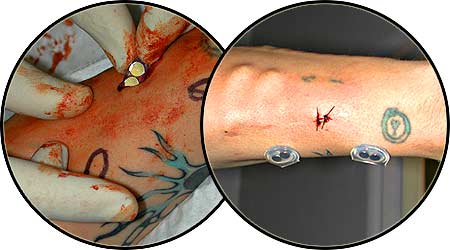
Jesse’s own magnetic implants, for utility rather than sensation.
Photos courtesy of Steve Haworth and Jesse Jarrell.Thank you to Todd for taking the time out to talk to us. If you’d like to contact him, you can do so via email at odd1 at onebox.com. If you are looking to have this procedure or one like it done yourself, contact Steve Haworth via stevehaworth.com.

Shannon Larratt
BMEzine.com
-
To Janet Jackson and Justin Timberlake: Thank You! – Through the Modified Looking Glass
Written by

To Janet Jackson and Justin Timberlake:
Thank You!
“We live in an atmosphere of shame. We are ashamed of everything that is real about us; ashamed of ourselves, of our relatives, of our incomes, of our accents, of our opinion, of our experience, just as we are ashamed of our naked skins.”– George Bernard Shaw
-
Fish Piercing? [The Publisher’s Ring]
Written by

Fish Piercing? What censorship accomplishes, creating an unreal and hypocritical mythology, fomenting an attraction for forbidden fruit, inhibiting the creative minds among us and fostering an illicit trade. Above all, it curtails the right of the individual, be he creator or consumer, to satisfy his intellect and his interest without harm. In our law-rooted society, we are not the keeper of our brother’s morals — only of his rights.
– Judith Crist

